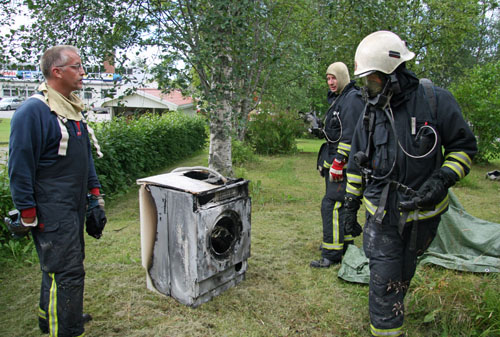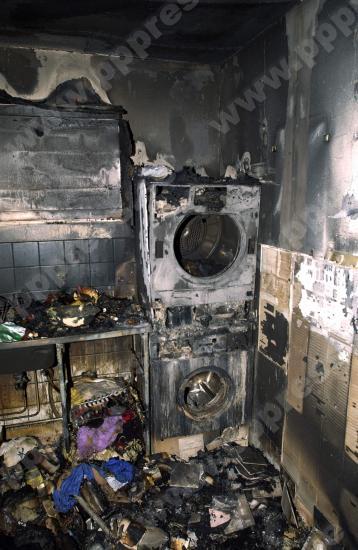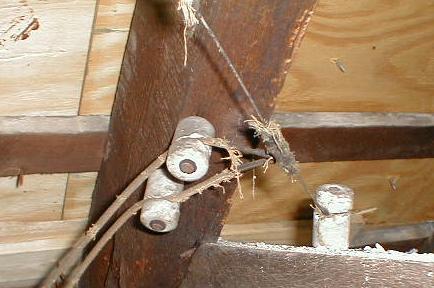|
Thread Number: 20939
Washing Machine Fires |
[Down to Last] |

|
| Post# 331685 , Reply# 1 2/22/2009 at 10:28 (5,534 days old) by youtubearecool () | ||
|
Some more Pics Electrolux. Motor caught fire. 
| ||
| Post# 331686 , Reply# 2 2/22/2009 at 10:32 (5,534 days old) by youtubearecool () | ||
|
Another pic of an Electrolux. This time it was an WH 280. The machine had leaked water quite awhile before the fire. 
| ||
| Post# 331701 , Reply# 3 2/22/2009 at 11:35 (5,534 days old) by animasinsulinpu () | ||
|
WOW!!! I would never leave home or go to sleep with the washer or DW on. What fun is that? Thanks for the pic and video....Bill in Az,USA..... | ||
| Post# 331731 , Reply# 4 2/22/2009 at 14:55 (5,534 days old) by sudsman () | ||
|
Notice where the most of the damages is in most of the pics The computer area. Not a one was a conventional washer.Pooy to the new modern crap! | ||
| Post# 331987 , Reply# 8 2/23/2009 at 20:24 (5,533 days old) by ronhic (Canberra, Australia) | ||
Bertrum...
...It happened (or used to) here too. My parents hotplates and oven are wired to a seperate fuse in the main fuse box just as the lights, power points and hot water service are... The main difference though is that the our power points are switched (as in the UK), but until recently, there was no requirement for separate switching for ovens/hot water services though there are exceptions.... Some people used to put a switch in for the hot water service so they could control when it heated etc....but this was not a requirement....we have one by default, my parents don't. However, we had our kitchen redone in 2006 and the oven/hotplates have an isolation switch on the wall near the cooker just as they do in the UK. Another thing to remember is that the UK and parts of the world that use the UK power point system, such as Hong Kong, have fuses in the plugs. The vast majority of countrys do not but rely on the main fuse box for protection. As an example, my parents house has the following main fuses 2x lights 2x power points Stove oven hot water service ...as well as a main on/off switch. Until 2004, they had simple wired fuses that if one blew, you took the fuse out, replaced the wire with some of appropriate rating and plugged in. They have since changed their fuse box to a circuit breaker system. The majority of houses in Australia probably still have simple, wired fuses.... | ||
| Post# 332059 , Reply# 11 2/24/2009 at 06:42 (5,532 days old) by toggleswitch2 () | ||
|
Meaning gas or oil fired systems that don't have cooling usually don't have an "OFF" position on the thermostst. Electric heaters in each room do. | ||
Post# 332149 , Reply# 14 2/24/2009 at 21:08 (5,532 days old) by revvinkevin  (Tinseltown - Shakey Town - La-La Land) (Tinseltown - Shakey Town - La-La Land) |
||
|
Washing machine fires! | ||
| Post# 332360 , Reply# 23 2/26/2009 at 03:25 (5,530 days old) by askomiele (Belgium Ghent) | ||
|
@dj-gabriele Don't know how it is in Italy, but here we must have 2 RCD protectors. One for the appliances in wet area's (washer, dishwasher, bathroom) max 300mA and above that 300mA for the whole house. Don't know if this is so in Europe, I guesse not because the Netherlands has other regulations. | ||
| Post# 332367 , Reply# 25 2/26/2009 at 05:52 (5,530 days old) by mielabor () | ||
|
My (Netherlands) RCD is 30 mA and I believe that that is the common type here. I must say that they do like power-hungry appliances in Italy: my vacuum cleaner is 700 W, iron 750 W, water kettle 1600 W, toaster 450 W and all function quite satisfactorily. | ||
| Post# 332374 , Reply# 27 2/26/2009 at 07:00 (5,530 days old) by toggleswitch2 () | ||
|
Come to think of it, aren't most "international" homes and buidlngs made of concrete with rebar? Here, in the northeast, private homes are still wooden frame constrtuction. So we need the MOST fire protection and we appear to have the least.......... | ||
| Post# 333271 , Reply# 31 3/2/2009 at 18:38 (5,526 days old) by toggleswitch2 () | ||
|
Mr.X Speaks...and I learn. Thank you! CLICK HERE TO GO TO toggleswitch2's LINK | ||
| Post# 333321 , Reply# 33 3/3/2009 at 00:28 (5,526 days old) by pturo (Syracuse, New York) | ||
|
Well, it just all just scares the shit out of me, to be technical. | ||
| Post# 333437 , Reply# 36 3/3/2009 at 15:34 (5,525 days old) by iheartmaytag (Wichita, Kansas) | ||

If'n you all wants to be scared. When I bought my house which is 73 years old. It had the old knob & tube (or knob and clete) wiring in it. My insurance company demanded that this be changed before we could close on the house. They estimate that there are thousands of houses in our area, built from the 30's to the 50's that still has this wiring in it. Scary 
| ||
| Post# 333882 , Reply# 38 3/5/2009 at 16:02 (5,523 days old) by rolls_rapide (.) | ||
|
Lighting Whatever happened to the proposed LED lights for the home, that were supposed to be super efficient and not need replacing? | ||
Post# 334075 , Reply# 41 3/6/2009 at 19:47 (5,522 days old) by paulg  (My sweet home... Chicago) (My sweet home... Chicago) |
||
Think outside the box...
I studied appliance fires in the past - including laundry fires. You all bring up many valid points. Here are a few more to consider... There are a zillion reasons a washer or dryer catches fire. Electrical failure is a cause to be sure. I've even know of underwire bras to catch laundry appliances on fire. You're noticing the trends such as front-loaders. Interestingly (but not surprisingly) the fire report discussed is from outside the USA. Two additional causes of fires to keep in mind. I'm not making these up - the industry knows these causes. First: Self-extinguishing plastics. The use of self-extinguishing plastic STOPS a lots of fires early in the USA. Guess what? MANY countries around the world DO NOT use self-extinguishing plastic! Once a unit manufactured with standard plastic starts on fire not much will stop it but a fireman. I believe we are safer in the USA due to widespread use of self-extinguishing plastic. Second: Detergent. And you experts probably know where I'm going. Back in the 1960s and 1970s, detergent had ENZYMES. That detergent was very effective ... at WHAT?? Can you guess? ANSWER: Removal of oils from cotton. After enzymes were removed from detergent in USA, dryer fires went up and up. Nowadays, the USA is going more toward the European trend of using front-loaders. Good idea. However, you must use a different detergent ("high-efficiency") which (as I am told) isn't particularly good at removing oils from cotton. Oil in cotton can spontaneously combust particularly in the dryer. Guess what? Dryer fires (or washer-dryer fires) are AGAIN on the rise in the USA. Oh yes our laundry appliances are getting more "efficient" in the USA.. but are our clothes getting CLEANER? Personally I think not. | ||
Post# 334274 , Reply# 46 3/8/2009 at 10:14 (5,520 days old) by kenwashesmonday  (Carlstadt, NJ) (Carlstadt, NJ) |
||
|
Plastic Fires mrx wrote: "US regulations around plastic in appliances would be pretty much identical." I remember Garrard stopped selling record changers in the US because derlin plastic was no longer allowed in electric appliances here. Derlin was the secret to Garrard's trip mechanism. Ken D. | ||
Post# 334319 , Reply# 47 3/8/2009 at 16:54 (5,520 days old) by thomasortega  (El Pueblo de Nuestra Seņora de Los Angeles de Porciúncula) (El Pueblo de Nuestra Seņora de Los Angeles de Porciúncula) |
||
|
I donīt know how they do it today but... A few years ago, E-lux used to intentionally apply a coating in all fire retardant plastics to produce small amounts of smoke, to make the fire detectable by the smoke detectors or by itīs smell. Note that this coating only produces very small amount of smoke during the beginning of the fire. Iīm not sure about the other manufacturers, but Iīm almost sure all of them do the same. | ||
| Post# 334402 , Reply# 48 3/8/2009 at 21:31 (5,520 days old) by toggleswitch2 () | ||
|
~Dryer fires are typically caused by lint, not oils or waxy build up. But don't the afforemntioned oils and waxes act like glue causing a lint buildup? | ||
| Post# 334465 , Reply# 50 3/9/2009 at 10:01 (5,519 days old) by mrx () | ||
|
Take a look at these recalls! Scary : Have a browse through these : The sheer number of imported kids 'cosmetics' and face paint etc that contained lead just before xmas 2008 was really worrying. CLICK HERE TO GO TO mrx's LINK | ||
Post# 337327 , Reply# 55 3/24/2009 at 20:40 (5,504 days old) by sudsmaster  (SF Bay Area, California) (SF Bay Area, California) |
||

My Neptune washer/dryer set draws 10 watts even when off (to power the electronics, I guess). So I replaced the 110 volt outlet with a switched outlet. Into the outlet went a small 3-way surge protector. The washer and dryer (gas) plug into that. The Neptune remembers its settings so there is no problem removing power to it when it's not in use. It comes back up instantly with all its settings intact. This arrangement would also allow me to leave the washer door ajar to minimize mold/odors, but the washer has never had a mold/odor problem so I don't bother with that. | ||

 Comes to the Rescue!
Comes to the Rescue!